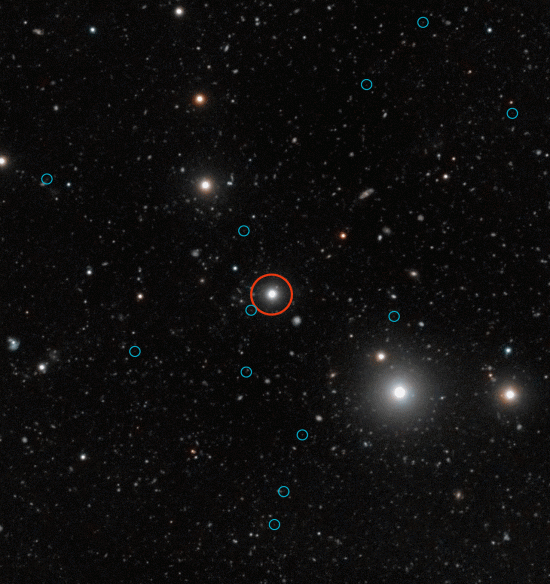
Blue circles mark the dark galaxies that are theoretically illuminated by the red-circled quasar. Credit: ESO, Digitized Sky Survey 2 and S. Cantalupo (UCSC)
Mar 14, 2013
Astronomers have finally observed “dark galaxies,” proving again that if you look hard enough for what you believe, you’ll find it (or something that’s close enough).
Dark galaxies, like the many other dark things in modern astronomy’s black box of unobservables, are predicted by the theory modern astronomers believe in. It’s always comforting to find evidence that suggests what you believe in really exists.
What they saw was tiny smudges of highly redshifted light near a highly redshifted pinpoint of light that they had previously named as a quasar. If the smudges are a fluorescent effect from hydrogen gas that the quasar is irradiating with its high ultraviolet output, and if redshift is a measure of distance (which is how the output of the quasar is determined), then the Goddess of Astronomy has blessed those conditionals with Her Unconditional Approval.
Men—and lately a few women—have been playing this naming game since the God of Genesis paraded His creations past Adam and had Adam name them. (It’s not recorded what God’s names were.) Philosophers call this game of naming things ontology—the nature of being. The name is a lexical shortcut for what you think you know about the nature of the beast.
Philosophers also note that epistemology—the nature of knowing—determines ontology. In this case, it means that the structure of humans’ sensory and cognitive operations—simplistically, what people believe—selects what they perceive and think. The resulting names (and their mostly unconscious connotations) then drop on the floor of the mind like so many sacks of garden-soil enrichment.
Some men prefer the enrichment from the bullpen; others from the chicken coop. The point is that different epistemological assumptions will populate the universe with different “things.” (Even in cases where the name is the same, the “things” envisioned by the partisans are different. Is an electron a particle with mass that impacts surfaces or is it a charge carrier in an electrical circuit?)
In this case of dark galaxies, Electrical Universe partisans see the redshift (z) of quasars as a consequence of their recent ejection from an active galaxy. Quasars with a z of 1 seem to be optically brightest, and they get dimmer to either side of that value. We may see quasars with a z of 1 to 2 in the Virgo and Fornax clusters, but ones with greater z are likely members of the Local Group. This quasar has a z of 2.4: It is probably nearby, small, and intrinsically dim.
The dark galaxies that Adamic Astronomers have so named would be wisps of hydrogen plasma. (Electric Universe people don’t have gas.) They are debris ejected with the quasar and waiting by the curbside for the cosmic garbage truck—the nearest Birkeland current, whose “pinch” force pulls matter toward its axis—to pick them up.
Mel Acheson












